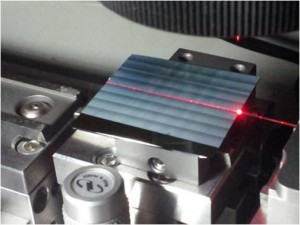Developing multifunctional materials, that is, chemical compounds synthesized in labs, which may be applied in several areas, is a research field increasingly explored in the chemistry departments of universities around the world. The Center for the Development of Functional Materials (CDMF), located at Universidade Estadual Paulista (UNESP), jointly with researchers from Universidade de São Paulo (USP), Universidade Federal de São Carlos (UFSCar) and Instituto de Pesquisas Energéticas e Nucleares (IPEN) have developed an original study using the chemical compound silver tungstate (Ag2WO4) as a resistive sensor to detect small amounts of ozone gas, providing an alternative to environmental solutions.
Luis Fernando Silva, researcher at CDMF, under the supervision of Professor Elson Longo, has investigated the properties of silver tungstate as an ozone gas sensor. Ozone (O3) is an oxidant gas, used in many technological applications, such as the food industry, drinking water treatment, medicine, microelectronics cleaning processes, among others. “Ozone has been successfully used to disinfect effluents, allowing a more efficient drinking water treatment. However, when there are high amounts of this gas in the atmosphere, it becomes harmful, especially to human health, causing serious conditions as headaches, burning and stinging in the eyes, difficulties to breath and lung damages”, he said.
In 2013, researchers from CDMF identified a way to stimulate the growth of nanoparticles of silver in the silver tungstate compound itself. Thereby, the material developed a number of properties that may be used in different sectors, such as health, environment, and technology.
Encouraged by this breakthrough, the researchers studied silver tungstate as a resistive gas sensor. “The preliminary results qualified this compound as a great gas sensor. In one of our trials, we identified that silver tungstate displayed an excellent performance detecting ozone. That was the first time in which this compound was used as a resistive gas sensor”, explained the researcher. The obtained results were published on the journal Nanoscale, a renowned source on the subject.
Silva also explains that following this work, the main goal will be examining the sensibility of silver tungstate when detecting other gases, such as nitrogen dioxide (NO2), ammonia (NH3), ethanol (C2H6O), or even humidity. “These are parameters that enable the potential commercialization of this material”, he stated.
The initiative results from the interaction between CDMF and the INCTMN (National Institute of Science and Technology for Nanotechnology Materials).
Exposition to ozone gas
Ozone is a gas found in the higher layers of the atmosphere, acting as a filter against the solar ultraviolet radiation that comes down to Earth. The gas is not natural where living beings live, presenting a negative impact to health. It is formed by the reactions between gases created by combustions, as in vehicles, for example.
The World Health Organization (WHO) recommends avoiding the exposition to ozone gas above 120 ppb (parts per billion). Based on this date, the constant detection and measurement of the levels of ozone contained in the atmosphere or in certain environments remains indispensable.

